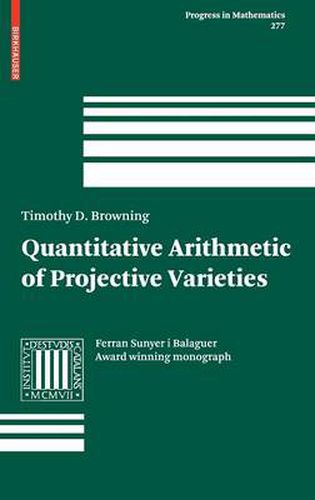Readings Newsletter
Become a Readings Member to make your shopping experience even easier.
Sign in or sign up for free!
You’re not far away from qualifying for FREE standard shipping within Australia
You’ve qualified for FREE standard shipping within Australia
The cart is loading…






This title is printed to order. This book may have been self-published. If so, we cannot guarantee the quality of the content. In the main most books will have gone through the editing process however some may not. We therefore suggest that you be aware of this before ordering this book. If in doubt check either the author or publisher’s details as we are unable to accept any returns unless they are faulty. Please contact us if you have any questions.
OverthemillenniaDiophantineequationshavesuppliedanextremelyfertilesource ofproblems. Their study hasilluminated everincreasingpoints ofcontactbetween very di?erent subject areas, including algebraic geometry, mathematical logic, - godictheoryandanalyticnumber theory. Thefocus ofthis bookisonthe interface of algebraic geometry with analytic number theory, with the basic aim being to highlight the ro le that analytic number theory has to play in the study of D- phantine equations. Broadly speaking, analytic number theory can be characterised as a subject concerned with counting interesting objects. Thus, in the setting of Diophantine geometry, analytic number theory is especially suited to questions concerning the distribution of integral and rational points on algebraic varieties. Determining the arithmetic of a?ne varieties, both qualitatively and quantitatively, is much more complicated than for projective varieties. Given the breadth of the domain and the inherent di?culties involved, this book is therefore dedicated to an exp- ration of the projective setting. This book is based on a short graduate course given by the author at the I. C. T. P School and Conference on Analytic Number Theory, during the period 23rd April to 11th May, 2007. It is a pleasure to thank Professors Balasubra- nian, Deshouillers and Kowalski for organising this meeting. Thanks are also due to Michael Harvey and Daniel Loughran for spotting several typographical errors in an earlier draft of this book. Over the years, the author has greatly bene?ted fromdiscussing mathematicswithProfessorsde la Bret’ eche,Colliot-Th’ el’ ene,F- vry, Hooley, Salberger, Swinnerton-Dyer and Wooley.
$9.00 standard shipping within Australia
FREE standard shipping within Australia for orders over $100.00
Express & International shipping calculated at checkout
This title is printed to order. This book may have been self-published. If so, we cannot guarantee the quality of the content. In the main most books will have gone through the editing process however some may not. We therefore suggest that you be aware of this before ordering this book. If in doubt check either the author or publisher’s details as we are unable to accept any returns unless they are faulty. Please contact us if you have any questions.
OverthemillenniaDiophantineequationshavesuppliedanextremelyfertilesource ofproblems. Their study hasilluminated everincreasingpoints ofcontactbetween very di?erent subject areas, including algebraic geometry, mathematical logic, - godictheoryandanalyticnumber theory. Thefocus ofthis bookisonthe interface of algebraic geometry with analytic number theory, with the basic aim being to highlight the ro le that analytic number theory has to play in the study of D- phantine equations. Broadly speaking, analytic number theory can be characterised as a subject concerned with counting interesting objects. Thus, in the setting of Diophantine geometry, analytic number theory is especially suited to questions concerning the distribution of integral and rational points on algebraic varieties. Determining the arithmetic of a?ne varieties, both qualitatively and quantitatively, is much more complicated than for projective varieties. Given the breadth of the domain and the inherent di?culties involved, this book is therefore dedicated to an exp- ration of the projective setting. This book is based on a short graduate course given by the author at the I. C. T. P School and Conference on Analytic Number Theory, during the period 23rd April to 11th May, 2007. It is a pleasure to thank Professors Balasubra- nian, Deshouillers and Kowalski for organising this meeting. Thanks are also due to Michael Harvey and Daniel Loughran for spotting several typographical errors in an earlier draft of this book. Over the years, the author has greatly bene?ted fromdiscussing mathematicswithProfessorsde la Bret’ eche,Colliot-Th’ el’ ene,F- vry, Hooley, Salberger, Swinnerton-Dyer and Wooley.